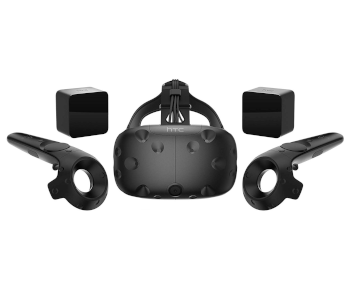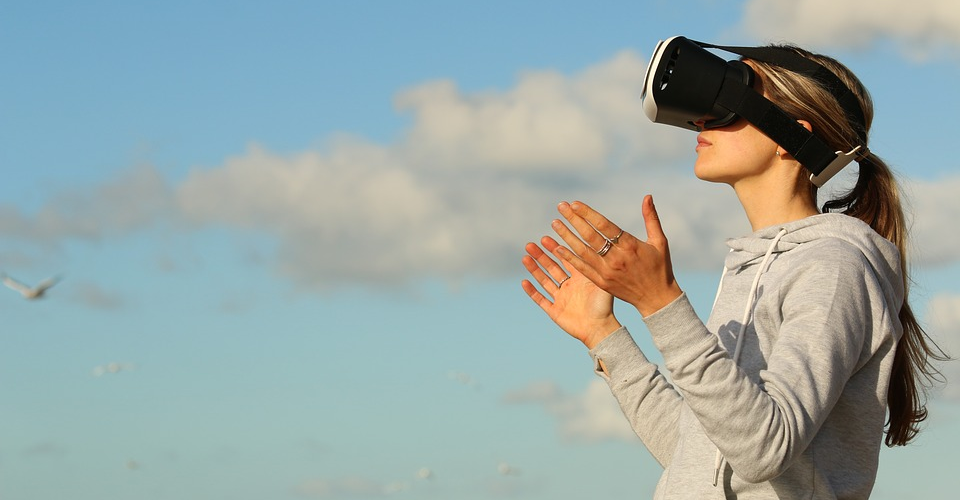The History of VR: When was it created and who invented it?
Virtual Reality was once the stuff of sci-fi, and then it became real. Who would have thought it, and in such a short space of time? This piece breaks down at the history of VR in an easy to digest format. Keep reading to learn how VR started, what happened, and where we’re at now. I end the piece with a snapshot of where virtual reality is likely to take us in the years ahead.
First, let’s look at what VR is before we get into the story of this incredible technology.
Virtual Reality Defined

The idea behind VR is to create an illusion of seeming reality. It makes us feel present in an artificial environment. It wasn’t always computer-generated imitations either. Artists from the 19th century created panoramic paintings or 360° murals. This artwork filled the entire visual field encompassed by human eyes. Thus, it would captivate the viewer’s imagination and make them feel “present.”
The ‘Battle of Borodino’ is an excellent example of 360-degree artwork. It’s a 1912 masterpiece painted by Russian artist, Franz Roubaud. The painting is an incredible 360° battlefield experience [1].
Today’s virtual reality is a far cry from those early 360° murals. Now we use computer technology to generate simulated environments. It’s a truly immersive and interactive three-dimensional experience that appears to surround the person. High-end systems are so lifelike that they can even stimulate the user’s natural senses. That includes vision, touch, hearing, and even smell [2].
The rest of this piece walks through the VR’s timeline of events which began in the 1950s.
1956 The Sensorama Simulator
Meet the ‘Father of Virtual Reality,’ Morton L. Heilig. This man was an American inventor, philosopher, and cinematographer. He was indeed a leading visionary of his time. His focus was firmly in the future, always exploring new ideas and where they might lead. Heilig created the first-ever VR machine called the Sensorama. It was a type of booth that could accommodate up to four adults [3], [4].
Heilig’s multi-sensory Sensorama gave a glimpse into future cinema. It used multiple technologies that simulated all the human senses. The booth exposed partakers to full-color 3-dimensional video and audio. There were also smells, vibrations, and various atmospheric effects like the wind.
1960 The Telesphere Mask
Morton Heilig also patented an invention called the Telesphere Mask in 1960. It was the first-ever head-mounted display device or HDM. His mask provided the wearer with 3D stereoscopic images and full stereo sound. It was simple and effective but didn’t have any motion-tracking yet [5].
1961 Headsight
In 1961, two Philco Corporation engineers, James Bryan, and Charles Comeau, developed Headsight. It was the first HDM with motion tracking technology. Inside the unit was two video screens, one for each eye. Headsight was not created as a virtual reality (VR) headset, though. It was to be a military tool, used to view potentially hazardous situations from a distance.
Headsight’s magnetic tracking system determined the direction of the wearer’s head. Head movements moved a remote camera. That’s how the soldier would explore a secluded setting [6].
1965 The Ultimate Display
Ivan Sutherland—affectionately named the ‘Father of Computer Graphics,’ has a place in VR history. He had an HMD project entitled ‘The Ultimate Display.’ It worked by connecting the HMD to a computer programs’ stereoscopic display to enable a 3-dimensional effect. Virtual shapes in the form of 3D wireframes changed perspective with the movements of the wearer’s head.
The 3D wireframes appeared superimposed in front of real backgrounds. However, the Ultimate Display was heavy and cumbersome. A mechanical arm suspended the device above the wearer’s head. Thus, it never saw use outside of lab experiments. Still, many industry experts view Sutherland’s contraption as the birth of AR or augmented reality [7].
1966 The Flight Simulator
Military engineer and pioneer, Thomas Furness, created the first-ever Air Force flight simulator. His creation supported the progression of virtual reality systems due to generous funding for VR. The simulator proved invaluable in the training of new pilots. Development in VR continued as the demand for better flight simulators grew. There wasn’t any call for VR entertainment systems—yet [8].
1968 The Sword of Damocles
Sutherland and his student, Bob Sproull, created the very first VR/AR head-mounted display (HDM). The contraption connected to a computer, not a camera. Its construction consisted of two cathode-ray tubes (CRTs). These CRTs were affixed to cylindrical units that had half-silvered mirrors embedded in prisms. This arrangement let the wearer see superimposed images in the world around them.
The tracking system allowed the 3D models to change perspective with head movements. The design was primitive, weighty, and uncomfortable to wear for extended periods. The so-called Sword of Damocles never made its way out of the lab for those reasons [9].
1972 180-Degree Flight Simulator

The General Electric Corporation (GE) had developed the computerized flight simulator by 1972. Three screens surrounded its training cockpit to give trainee pilots a 180° field of view or FOV. This was a revolution. It provided virtual flying conditions never experienced before. GE improved the displayed picture so much that route familiarization became a simulator reality [10].
1975 VIDEOPLACE
Computer artist, Myron Kreuger, is a first-generation researcher of VR and AR reality. He’s also among the first computer researchers to find a way into the virtual world. VIDEOPLACE used two rooms that could be in the same location or opposite sides of the globe. Participants would see themselves projected onto a large screen. Those in separate boxes would see the others projected image.
Participants used their shadows to interact in the virtual space. These shadows could touch and be touched, resize, rotate, and change color [11].
1977 The Aspen Movie Map
This was the year that saw the Aspen Movie Map. It was a groundbreaking hypermedia system developed at the Massachusetts Institute of Technology (MIT). Senior research scientist, Andrew Lippman, led a team that created an interactive virtual tour of Aspen city, Colorado. Users could navigate the local streets, enter buildings, and even change seasons.
It was possible to choose random paths through the streets, but not stray from the center. Also, each movement was in 10ft steps. Users would interact using a dynamic-generated menu system. They’d select icons from a touchscreen interface to choose preferred speeds and viewing angles. Google’s Street View is the Aspen Movie Map’s legacy [12], [13].
1979 The VITAL Helmet
The US military was testing the potential for head-mounted display units by 1979. The idea was to project virtual images straight into a pilot’s eyes. The reduction in size and expense compared to their current simulation systems would be massive. McDonnell-Douglas Aircraft Corp led the way. It managed to integrate VR into its head-mounted display (HMD) and called it the VITAL helmet.
The HMD had a head tracker. It worked by following the wearer’s eye movements to match the CGI (computer-generated imagery). Unfortunately, the VITAL helmet was not practical. It was too bulky, uncomfortable, and displayed unnatural viewing. Still, this military development was the start of great things to come. That included the modern computer and arcade games [14], [15].
1982 The Optical Glove
Datagloves are electromechanical devices. They have special sensors to sense hand movements and interact with computer interfaces. The first data glove was the brainchild of Richard Sayre, Dan Sandin, and Thomas Defanti in 1977. That was at the Electronic Visualization Laboratory, University of Illinois. Thomas Zimmerman invented the first optical glove in 1982, based on the Sayre model.
A year later, Bell Laboratories’ Gary Grimes, gave us the Digital Data Entry Glove. It was more flexible and had better touchy-feely characteristics than any of the previous creations [16], [17].
1985 The NASA Project

US Professor, Scott Fisher, was busy working on a virtual reality system for astronauts. His work took place at NASA’s Ames Research Center in California. It was called the Virtual Environment Workstation Project. The aim was for astronauts to control robots outside of a space station from the inside. It would save lots of time and—more importantly—reduce personal risk.
The head-mounted display (HMD) had ultra-wide-angle optics with a 180° field of view (FOV). The team developed a camera system with matching optics. High-tech instrumented gloves would control the robotic arms. Five years on saw the Virtual Interface Environment Workstation (VIEW), [18], [19].
1986 The Super Cockpit
Dr. Tom Furness is a pioneer and grandfather of VR. He’s also the author of the Super Cockpit program of 1986. Furness describes it as the magic system, i.e., magic helmet, flight suit, and gloves. Combined, the Super Cockpit sends its wearer to a fully-immersive virtual world. Features were voice-actuated control, head-aimed control (including eye control), and a virtual hand controller.
Furness’ system had an intuitive touch-sensitive panel. It projected critical information, e.g., avionics data, computer-generated maps in 3D, forward-looking IR, and radar imagery. All this data went into the immersive, three-dimensional virtual space [20].
1987 The Virtual Cockpit
This was the year when British Aerospace built on Dr. Tom Furness’ Super Cockpit. It was a concerted effort with experts from fields of science, engineering, and cockpit specialists. The HMD was similar in many ways but with the addition of speech recognition and vibrotactile feedback. It was now a complete system with head, eye, and hand tracking, plus 3D visuals and audio.
American computer scientist and philosophy writer, Jaron Z., coined the now familiar term, Virtual Reality. The media exposure that followed gained momentum faster than at any other time [21].
1989 Power Glove
An entire range of industries started to take an interest and began to explore the potential of VR. The Nintendo Entertainment System gave us the Power Glove. A vast marketing campaign highlighted the VR mechanics and seeming magic of this controller accessory. Initially, it was top of every gamer’s wish list. Sadly, disappointment soon followed due to inaccurate and hard-to-use controls [22].
1990 The VR Arcade Machine Revealed
Multi-player virtual reality arcade machines were announced to the world in 1990. Dr. Jonathan Waldern (Ph.D.), had developed the first public VR game systems. His Virtuality Arcade Machines and first-ever VR game, Dactyl Nightmare, went on to become a huge success. Today, Waldern is a named inventor for more than 90 patents in VR and AR optical devices [23].
1991 Mars Robots & 3D VR Gaming
Virtual reality was rarely out of the headlines by 1991. A NASA scientist called Antonio Medina went on to design a VR system for controlling the Mars robot rovers from the earth. Scientists called the system, Computer Simulated Teleoperation [24].
The Virtuality Group started to roll out its VR arcade machines. These immersive pod-like contraptions had VR headsets and real-time stereoscopic 3D images. The mass production of VR arcade machines had arrived, giving popular 2D games VR versions [25].
1994 Sega VR

The 1990s was the golden era for VR enthusiasts. The much-anticipated Sega VR headset was in the final development stages. There were to be two versions, one for arcades and another for games consoles. The company scrapped the console version before its release. It focused solely on the arcade version instead, which came out in 1994. The first-ever consumer VR headset had to wait a while [26].
1995 CyberMaxx by VictorMaxx Technologies
VictorMaxx released a consumer head-mounted device (HDM) called CyberMaxx in 1995. The VR helmet used two active, full-color video displays for stereoscopic vision. The unit had a 3D motion tracking module to exploit the immersive VR experience. VictorMaxx has since gone out of business, but it’s still possible to find its CyberMaxx HMD for sale online [27].
1997 Virtual Vietnam
In 1997, virtual reality was used to help treat US Vietnam combat veterans. VR therapy aimed to help those who had post-traumatic stress disorder (PTSD). The program was aptly named Virtual Vietnam. Participants entered a computer-generated environment. There were integrated computer graphics in real time with visual displays and body tracking devices.
The results were astonishing. Patients clinician-rated PTSD decreased at an average of 34%. And self-rated PTSD saw a 45% decrease [28], [29].
2001 The SAS Cube
The first-ever cubic room for PC came about in 2001. What followed next was the Virtools VR pack—an add-on library for Virtools Dev. Developers now had a platform of 3-dimensional visualization tools at their disposal. VR was now becoming better known at the public level [30], [31].
2007 Google Street View

In 2007, Google gave Street View to the world. The original version only covered 5 major US cities and their surrounding suburbs. Today, Google Street View coverage is global. It’s an interactive feature of Google Maps that lets users view and navigate the virtual world. The panoramic street level is 360° horizontal and 290° vertical. It’s was—and continues to be—a fascinating, immersive experience [32].
2010 Street View Gets Stereoscopic 3D Mode
Google Street View moved to the next level in 2010. It was the year that gave anaglyph 3D imagery to the program. You had to wear cheap Anaglyph 3D glasses to experience it [33], [34].
2012 The Oculus Rift Virtual Reality System
Oculus Rift is now an impressive lineup of VR headsets developed and made by Oculus VR. It all began with a Kickstarter campaign in 2012. It was a successful project that raised around $2.4M from 10,000 contributors. Facebook bought Oculus two years later in 2014 for $2 billion [35], [36].
2014 More VR Launches
VR had gained momentum by 2014. Facebook’s purchase of the Oculus VR company helped to fuel enthusiasm. Sony announced their upcoming Project Morpheus the same year—a VR headset for its PS4. Google released its low-cost Cardboard that blended everything into a VR headset via a smartphone. Samsung also announced its Samsung Gear VR for Galaxy smartphones [37], [38].
2015 VR Viewing
Everyone was talking about virtual reality by 2015. Companies launched new projects or updated existing ones. We saw the BBC’s 360° video of a migrant camp in Syria, and the Wall Street Journal’s VR roller coaster. The Washington Post gave us a VR tour of the Oval Office. And media company RYOT made a short VR film about solitary confinement in a US prison [39], [40], [41], [42].
2016 The Start of VR
Most people knew something about virtual reality by 2016. Previous years had introduced VR innovations and next-level technologies. But 2016 was the start of VR. We now had affordable, highly sophisticated systems available from competing companies. Immersive technology had come of age. It was set to find its way into everyday lives in all manner of fascinating and exciting ways [43].
2017 VR Gets off to a Slow Start
After all the buildup from the previous year, 2017 got off to a much slower start than expected. Some say VR was overhyped and the lackluster interest was a result of overkill. Fortunately, the slow start only lasted for the first half of 2016. The second half of that year saw a significant boost in products and sales, with a reenergized interest in the many competing VR headsets on offer [44].
2018 – Present Day
Virtual reality is here to stay in all its forms. No one knows for sure where it’s heading, but we do know it’s going to be electrifying. There is nothing more immersive than VR digital environments. The development costs are much lower than 30 years ago. New developer tools, knowledge, and knowhow have no limits other than imagination—it seems. Watch this space.
The Conclusion
This historical view of virtual reality is brief. There are bound to be a few unmentioned names, forgotten inventions, and gaps in the timeline. Even so, it highlights the memorable moments from the 1950s through to the present day. Knowing something of how VR started, what happened along the way, and where we’re at today adds to its fascination.
We’ll continue to update this page periodically as and when warranted.
Resources
1. https://www.atlasobscura.com/places/borodino-panorama
2. https://www.merriam-webster.com/dictionary/virtual%20reality
3. https://www.nndb.com/people/884/000116536/
4. https://www.engadget.com/2014/02/16/morton-heiligs-sensorama-simulator/
5. https://publishing.rcseng.ac.uk/doi/full/10.1308/rcsbull.2015.424?trendmd-shared=1&mobileUi=0&
6. https://www.sutori.com/item/1961-headsight-developed-by-comeau-and-bryan/
7. http://worrydream.com/refs/Sutherland%20-%20The%20Ultimate%20Display.pdf
8. https://ise.washington.edu/facultyfinder/thomas-a-furness
9. https://www.researchgate.net/figure/The-Sword-of-Damocles/
10. https://aviationvoice.com/evolution-of-full-flight-simulators/
11. https://aboutmyronkrueger.weebly.com/videoplace.html
12. https://www.media.mit.edu/people/lip/overview/
13. https://computerforum.eu/aspen-movie-map/
14. https://apps.dtic.mil/dtic/tr/fulltext/u2/a240170.pdf
15. https://epdf.pub/virtual-reality-simulating-and-enhancing-the-world-with-computers/
16. https://www.techopedia.com/definition/3634/dataglove
17. https://www.britannica.com/biography/Thomas-Zimmerman
18. https://www.nasa.gov/ames/spinoff/new_continent_of_ideas/
19. https://en.wikipedia.org/wiki/Scott_Fisher_(technologist)
20. https://www.seattleweekly.com/arts/seattles-virtual-road-to-transcendence/
21. http://cradpdf.drdc-rddc.gc.ca/PDFS/unc57/p523539.pdf (see 3.1.1.5)
22. https://www.abc.net.au/tv/goodgame/stories/s2248843.htm
23. https://www.theinformation.com/contributors/177947
24. http://multivisionresearch.pcriot.com/gallery/antoniomedina/
25. https://en.wikipedia.org/wiki/Virtuality_(gaming)
26. https://www.designnews.com/electronics-test/story-sega-vr/
27. http://www.mellottsvrpage.com/index.php/cybermaxx-virtual-reality-helmet/
28. https://www.semanticscholar.org/paper/Virtual-Reality-Exposure-Therapy-for-PTSD-Vietnam/
29. http://gotz.web.unc.edu/files/2013/10/icat.pdf
30. https://www.researchgate.net/figure/A-Immersive-Display-The-SAS-CUBE-TM/
31. http://www.filefacts.com/virtools-vr-pack-info
32. https://whatis.techtarget.com/definition/Google-Street-View
33. https://www.yourdictionary.com/stereoscopic-3d
34. http://geeknizer.com/google-street-view-3d/
35. https://en.wikipedia.org/wiki/Oculus_Rift
36. https://arstechnica.com/gaming/2014/03/facebook-purchases-vr-headset-maker-oculus/
37. https://vr.google.com/cardboard/
38. https://en.wikipedia.org/wiki/Samsung_Gear_VR
39. https://www.bbc.co.uk/rd/projects/360-video-virtual-reality
40. https://www.wsj.com/articles/roller-coasters-ride-into-dizzying-realm-of-VR/
41. https://www.washingtonpost.com/obama-the-first-VR-president/
42. https://www.youtube.com/watch?time_continue=2&v=nDwulYcboDU
43. https://kotaku.com/the-state-of-virtual-reality-in-2016-1790201426
44. https://www.forbes.com/sites/moorinsights/2018/01/02/virtual-reality-in-2017/

